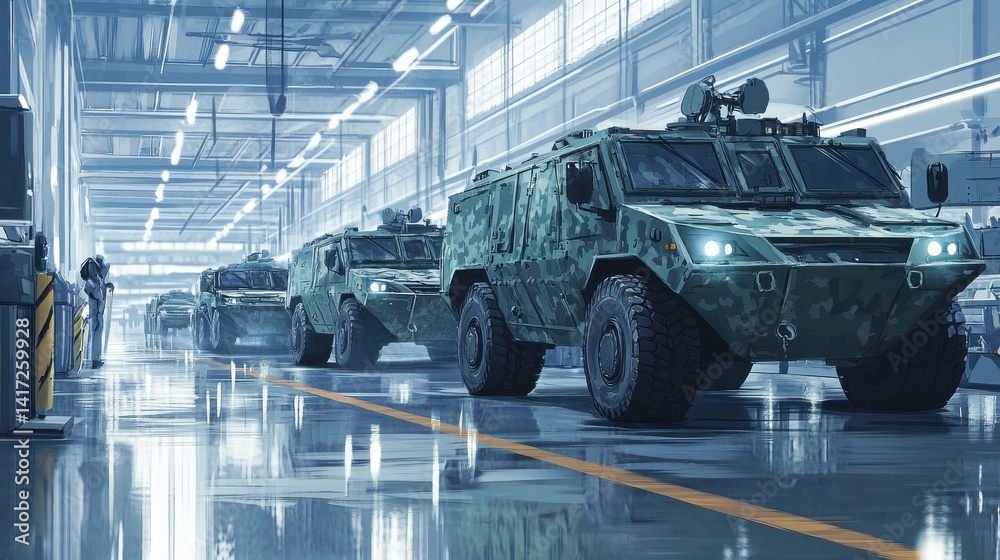Military vehicle fleets operate in an unforgiving paradox: maximum availability demanded with minimum resources allocated. In contested environments where every asset counts, defense organizations can no longer afford the luxury of inefficiency. The global military vehicle sustainment market, valued at $17 billion in 2023 with projected 5% annual growth, reflects an industry under pressure to modernize operations while managing aging platforms.
Traditional approaches—reactive maintenance schedules, siloed data systems, and rigid deployment patterns crumble under the weight of modern operational demands. Fleet commanders face cascading challenges: vehicles out of service longer than necessary, maintenance resources stretched thin, and critical mission windows missed due to readiness gaps.
The solution lies not in working harder within broken systems, but in fundamentally reimagining how fleets are optimized. Advanced simulation platforms, quantum-inspired algorithms, and integrated decision-support tools now offer defense leaders the mathematical rigor and operational fidelity needed to transform logistics from a cost center into a strategic advantage.
Challenges in Defense Fleet Management
Defense fleet management today operates under constraints that would cripple civilian logistics operations yet mission failure is not an option. Understanding these challenges is the first step toward systematic optimization.
1.Over-Servicing & Maintenance Inflexibility
Rigid maintenance schedules designed for worst-case scenarios often pull mission-ready vehicles offline unnecessarily. When 30-40% of a fleet sits in maintenance bays receiving services they don’t need, mission planners scramble to cover critical operations with insufficient assets. Over-servicing can inflate maintenance costs by 20-35% while reducing vehicle utilization rates below 50% well beneath the 70-85% benchmark that indicates efficient operations.
Scheduled maintenance assumes uniform wear, but vehicles in different environments and mission profiles face vastly different stresses. Inflexible schedules ignore these realities, causing inefficiencies that compound across entire fleets.
2.Data Silos & Lifecycle Cost Blindspots
Fleet information fragments across maintenance systems, supply chains, financial databases, and operational logs. Without integrated visibility, commanders make decisions based on incomplete pictures. Lifecycle cost analysis becomes guesswork, and strategic planning suffers from data gaps that hide both opportunities and risks.
Maintenance teams might replace components based on calendar schedules while operational data shows the vehicle has barely accumulated half its expected usage hours. Supply chain systems order parts based on historical consumption while ignoring real-time condition monitoring that could extend component life by months. The Government Accountability Office reports how fragmented data prevents accurate lifecycle cost analysis, causing premature replacements or prolonged economic operation that drives up maintenance costs and reduces reliability.
3.Need for Agility via Modularity
Modern conflicts demand rapid mission pivots from humanitarian support to combat operations to peacekeeping often with the same vehicle platforms. Legacy fleets designed for single-purpose missions struggle with this adaptability, forcing suboptimal compromises between capability and readiness.
Mission-specific modifications often entail extended downtime, specialized tooling, and technician expertise that may be unavailable in forward locations. Transitioning vehicles between configurations can take days, leaving missions uncovered. While modular architectures promise faster transitions, legacy platforms resist easy modification, requiring costly workarounds that compromise capability and availability.
4.Lack of Real-Time Condition Monitoring
Periodic inspections and calendar-based maintenance miss continuous vehicle health data now available via telematics and onboard diagnostics. This reactive approach wastes maintenance windows and allows minor issues to escalate into mission-critical failures.
Modern military vehicles generate thousands of data points per hour engine metrics, transmissions, hydraulics, electrical systems yet most fleets capture only a fraction during inspections. Real-time monitoring reveals patterns hidden from traditional methods, such as wear differences based on terrain and use. Without continuous data, maintenance relies on estimates that over-service some vehicles and miss incipient failures in others.
5.Resource Allocation and Workforce Constraints
Limited parts inventory, specialized technician availability, and budget pressures create bottlenecks cascading through fleets. Traditional allocation methods fail to optimize these scarce resources across competing priorities, leading to suboptimal readiness levels.
Specialized maintenance skills—hydraulics, electronic warfare, advanced armor repair require extensive training and are in short supply. Misallocation means high-priority vehicles sit idle while routine maintenance consumes expert attention. Parts inventory optimization becomes complex with unpredictable demand and disrupted supply chains, resulting in either excessive carrying costs or critical shortages grounding mission-essential vehicles.
Fleet Optimization Strategies & Approaches
Modern defense fleet optimization requires integrated strategies that address operational, technical, and economic factors simultaneously. These approaches move beyond incremental improvements to deliver transformational readiness gains.
Instead of focusing on isolated improvements, modern militaries adopt holistic strategies that align fleet availability, lifecycle cost, and mission adaptability. This ensures forces remain agile, sustainable, and fully mission-ready.
FMIS and Integrated Lifecycle Cost Analytics
Fleet Management Information Systems (FMIS) serve as the nervous system of optimized operations, connecting maintenance records, parts consumption, operational usage, and cost data into unified decision-support platforms.
By integrating lifecycle cost analytics, advanced FMIS tools reveal hidden patterns in vehicle performance, identify optimal replacement timing, and predict resource requirements across multiple mission scenarios.
Rationalizing Service Intervals
Extended service intervals for combat vehicles like the Abrams and Bradley have demonstrated significant readiness improvements without compromising reliability. This data-backed approach reduces downtime and enhances operational availability.
Interval optimization balances maintenance workload with real-world usage patterns. Instead of rigid schedules, vehicles receive service at the right time, improving fleet readiness while avoiding unnecessary maintenance costs.
Predictive & Condition-Based Maintenance (CBM+) via Telematics
Telematics systems and condition-based maintenance programs shift the paradigm from scheduled to intelligent servicing, a shift similar to how predictive maintenance of armoured fighting vehicles reduces downtime through real-time data insights.
Predictive algorithms enable maintenance teams to act precisely when needed—neither too early nor too late, cutting waste and ensuring vehicles remain battle-ready without excessive downtime.
Modularity & Adaptive Fleet Configuration
Modular vehicle architectures allow rapid reconfiguration for changing mission requirements. Instead of maintaining separate fleets for different roles, optimized systems deploy adaptable platforms.
Mission-specific modules can be quickly added or swapped while maintaining core mechanical reliability. This adaptability reduces redundancy, extends platform lifecycles, and lowers fleet costs.
Using Simulation & Optimization to Drive Fleet Decisions
Advanced simulation-driven optimization tools transform fleet management from reactive problem-solving to proactive strategic planning, enabling commanders to evaluate scenarios before they occur.
These technologies test scenarios, optimize trade-offs, and support data-driven decisions at operational speed, ensuring fleets remain both cost-efficient and mission-effective.
Agent-Based & Scenario Simulation for Scheduling & Supply
Agent-based models simulate complex fleet interactions under realistic operational conditions. They reveal emergent behaviors and bottlenecks invisible to traditional planning methods.
By testing maintenance schedules, supply configurations, and deployment patterns, scenario-based simulations help leaders stress-test decisions before committing resources in real missions.
Quantum-Inspired Multi-Objective Optimization for Fleet Readiness & Cost
Quantum-inspired optimization algorithms excel at solving multi-objective problems where traditional methods struggle, balancing readiness goals with lifecycle cost constraints.. Traditional methods often fail to resolve these competing demands.
Applied to fleet management, these algorithms help decision-makers align short-term operations with long-term modernization goals, ensuring sustained readiness without runaway costs.
Real-Time Digital Twin & Decision Support Dashboards
Digital twin simulation creates virtual replicas of entire fleets, continuously updated with real-world operational data, offering a live decision support environment for mission planning.These real-time models capture operational data for proactive insights.
Decision-support dashboards powered by digital twins allow commanders to run “what-if” scenarios, evaluating the impact of maintenance actions, deployment changes, or resource reallocations before implementation.
How BQP Enhances Defense Fleet Optimization
BQP’s quantum-powered simulation platform tackles the toughest computational challenges in military fleet management with advanced algorithms and defense-tailored workflows.
- Quantum-Inspired Optimization Solvers
Deliver up to 20× faster solutions for complex scheduling and routing problems, shrinking planning cycles from days to hours while integrating seamlessly with existing HPC infrastructure. - Physics-Informed Neural Networks (PINNs)
Boost predictive accuracy for maintenance planning and failure forecasting. With Quantum-Assisted PINNs (QA-PINNs), fleets gain reliability even in sparse-data environments and extreme operational conditions. - Real-Time Performance Dashboards
Provide live monitoring of optimization convergence, allow commanders to compare quantum vs. classical methods, and enable dynamic parameter adjustments. Route optimization alone has shown 15% cost reductions, further amplified by BQP’s quantum-enhanced algorithms. - Defense-Specific Workflows
Offer pre-configured templates built for military constraints, security standards, and operational demands ensuring solutions are purpose-built for defense rather than generic adaptations.
Bring BQP to Your Defense Operations
Discover how quantum-powered simulation and optimization can elevate your fleet readiness while minimizing costs and downtime. Connect with our team today to see BQP in action-Book a demo!
Implementation Roadmap
Successful fleet optimization deployment follows a structured approach that builds capability while proving value at each stage.
Phase 1: Pilot with Service Schedule Optimization Begin with a single vehicle class—typically high-value, high-usage platforms like main battle tanks or armored personnel carriers. Use BQP's optimization solvers to analyze current maintenance schedules against operational requirements, identifying opportunities for improved availability without reliability compromise.
Phase 2: Integrate Telematics Data Feed Connect real-time vehicle health data streams to BQP's simulation environment. Run parallel optimization scenarios comparing calendar-based versus condition-based maintenance strategies, quantifying readiness gains and cost impacts across realistic mission profiles.
Phase 3: Scale to Modular Asset Configurations Expand optimization scope to multi-vehicle mission packages and modular configurations. Use BQP's multi-objective algorithms to balance fleet composition, spare parts inventory, and technician allocation across diverse operational scenarios.
Phase 4: Institutionalize Strategic Decision Support Deploy BQP-enabled dashboards for senior leadership, providing real-time visibility into fleet readiness trends, optimization recommendations, and strategic trade-off analysis. Integrate outputs into formal planning and budgeting processes.
Conclusion & Strategic Outlook
Military vehicle fleet optimization has evolved from operational necessity to strategic imperative. In contested environments where logistics determine victory, defense organizations cannot afford inefficient fleet management practices that compromise readiness while inflating costs.
The convergence of quantum-inspired optimization, physics-informed modeling, and integrated decision support delivers unprecedented capability to military logistics leaders. Organizations leveraging these advanced tools transform fleet management from reactive maintenance scheduling to proactive strategic advantage.
BQP's quantum-powered simulation platform provides defense leaders the computational tools needed to optimize complex fleet decisions at operational speed. By combining real-world operational constraints with quantum-enhanced algorithms, military logistics evolves from cost center to force multiplier.
The question facing defense leaders isn't whether to adopt advanced fleet optimization—it's whether they can afford not to. In an era where every asset must contribute maximum value to mission success, quantum-powered fleet optimization becomes the difference between surviving contested operations and dominating them.
Explore how BQP helps defense leaders reduce operational risks, extend vehicle lifecycles, and maximize mission performance. Schedule a session with our experts to start building smarter fleets today.
FAQs
What is military fleet optimization?
Military fleet optimization is the process of maximizing vehicle availability, readiness, and mission effectiveness while minimizing maintenance costs, downtime, and resource consumption.
Why is traditional fleet management inefficient?
Traditional approaches rely on rigid schedules, siloed data systems, and reactive maintenance, leading to over-servicing, low vehicle utilization, and missed mission windows.
How do predictive and condition-based maintenance improve readiness?
Predictive and condition-based maintenance uses real-time telematics and data-driven algorithms to service vehicles precisely when needed, reducing unnecessary downtime and preventing mission-critical failures.
What role does modularity play in fleet management?
Modular vehicle architectures allow rapid reconfiguration for different mission requirements, reducing fleet redundancy, extending vehicle lifecycles, and increasing operational flexibility.
How do quantum-inspired and simulation-driven approaches enhance fleet optimization?
Quantum-inspired algorithms and advanced simulation platforms enable multi-objective optimization, scenario testing, and real-time decision support, delivering faster, robust, and near-optimal solutions for complex defense operations.





.png)
.png)




.svg)
.svg)
.svg)
.svg)